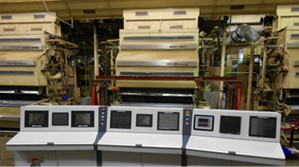Cotton gin operations are typically a semi-automatic operation, where cotton is transported from one machine process to the next, separating the cotton lint from the cotton seeds.
This was the basis for the original cotton gin created by Eli Whitney (anyone who grew up listening to Schoolhouse Rock remembers Eli Whitney from the
Mother Necessity song) — it separated the lint from the seeds, which saved a lot of tedious hand work.
Essentially, a cotton gin is a process that still uses the same concepts Eli Whitney developed in the 1800s, but it's obviously now more powerful and can handle larger amounts in a shorter time. The seed cotton is picked in the field in the form of modules. Those modules are loaded into the gin where they're broken up to get the seed cotton flowing. The manager of the gin then monitors such things as moisture and product flow through the sub-processes. The seeds are separated from the lint and the lint cotton gets pressed and consolidated into bales.
Gins usually run 24/7 during the harvesting season, so they can't afford any downtime, even a few minutes here and there. So you'll often hear the phrase, "
keep the stands in."

A
gin stand is the last piece of machinery to receive seed cotton before it heads into the pressing operation to make the cotton bales. It removes the lint from the seed with a series of saws. Then the lint goes one way, the seeds go another, and the trash goes a third.
It's maybe the most important part of the gin, so, keeping the stands in – a continuous flow into the stands - is one of the biggest industry headaches.
One reason is because the gin owners are paying labor costs, even during the machine's downtime. If a stand is clogged up and the gin isn't running, it doesn't matter if it's 2 or 3 hours, or even longer, the workers are still getting paid. And that payroll doesn't stop until the last bale has been ginned. So if the stands aren't in, the money is flowing out.
Cotton Gins are a Series of Sub-Processes
In a cotton gin, each sub process equipment comes from its manufacturer with basic controls. The gin operator monitors each sub-process and makes adjustments with the objective being to produce a targeted number of bales-per-hour of high-quality cotton.
This is where Kelley Electric comes in.
Kelley offers an integrated process control system called GinManager™, which uses sensors and monitors points in the gin to control the sub-processes all the way through pressing of the bales. This ensures the stands stay full instead of getting bogged down, or left empty as it waits for a slowdown to clear itself.
Each gin is different and each requires different control parameters in order to achieve maximum efficiency. GinManager™ is customized for every gin. But this is more than just an off-the-shelf process control system. When Kelley Electric installs a GinManager™ project, they check out the operation, and ask a lot of questions: How do you run your gin? What are the key points to control? They look for process bottlenecks and areas that slow down or break down, so they can find ways to improve the flow of material and reduce manual tweaking of the controls, programming the specific requirements into the gin's own GinManager™ system.
There is some core automation programming applicable for all gins, but to fine tune and tweak it for specific conditions is something no one else in the industry does. Kelley is the first, and they've got a new process that is changing how cotton ginning is done.
What Has Kelley Been Doing in the Cotton Gin Industry?
Until recently, everything they've been doing was retrofitting older gins and some that are not so old, modernizing their old methods with updated integrated control systems.
.jpg.aspx?width=300&height=224)
For the most part, everything they've done has been a retrofit. But recently, they were asked to install GinManagerTM in a brand new cotton gin being built in Alabama.
"We had started talking to these guys two years ago," said Ron Hickerson, President and COO of Kelley Electric. "The ownership had spent time over the last two years traveling and talking to our customers. And he told all his manufacturers that he only wanted their equipment, not their controls. He wanted GinManagerTM to control his gin."
Kelley is also getting more deeply involved in the ginning process with new acquisitions and capabilities. In August 2016, they purchased a moisture-sensing technology so they could better manage the moisture control systems — dryers and burners — and integrate that into the GinManager™ system.
"There are other process improvement items we are developing to help make gins more efficient, and several gins are already champing at the bit to wait for us to prove out," said Ron.
Their customers are seeing a lot of improvements in their efforts too. Ron said they had asked one customer who had been running GinManagerTM for two years about their assessment of the top two benefits of the system.
"The guy said, 'those stands stay in,'" said Ron. "Then he said, 'Now nearly everyone who works here can run this gin. Before, it was just me and one other guy.'"
As the cotton ginning expertise and experienced talent is fading away, that's becoming a bigger advantage for people to let Kelley provide this integrated process control system while the talent is still there.
If you would like to learn more about GinManagerTM and how Kelley Electric can help improve your cotton ginning process,
please visit the Kelley Electric website or contact us at
(573) 888-5395. or
(800) 325-8497.